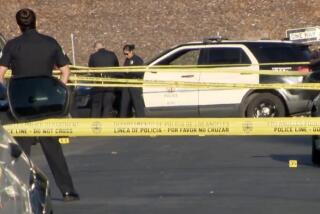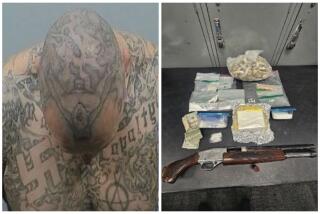Latino gang tried to force blacks out, indictment says
Federal prosecutors Tuesday accused members of a Latino street gang of a violent campaign to drive African American rivals out of their South Los Angeles area neighborhood, resulting in at least 20 killings in the last three years.
Capping an undercover investigation conducted over that period, authorities issued indictments that charged more than 60 members and associates of the Florencia 13 street gang with a long list of felonies. Prosecutors say the gang was trying to dominate the area’s drug trade as well as extort “rent” from prostitutes, vendors, drug dealers and others.
Much of the violence occurred in the Florence-Firestone neighborhood, a working-class unincorporated community of 60,000 north of Watts that went through a rapid shift in population starting in the 1980s. Once mostly black, the area is now home to many Mexican immigrants.
Officials said Latino gang leaders in recent years had sought to drive the remaining black gangs and their supporters from the neighborhood and had repeatedly ordered members to attack black rivals -- in some cases shooting them on sight.
The indictment’s description of sustained, deadly racial gang fighting provides evidence of a type of violence that is often discussed but seldom documented. Homicide statistics indicate that the vast majority of killings take place within racial or ethnic groups.
Florence-Firestone, however, appears to have been a murderous exception. Killings in the neighborhood peaked in 2005, when 41 homicides sparked widespread community outcry. As violence rose, the L.A. County Sheriff’s Department sent more than 60 additional deputies to the area and conducted several mass arrests aimed at reducing racial violence. The district attorney’s office devoted a special prosecutor to handle only Florence-Firestone homicides for two years.
Last year, homicides plummeted to 19.
Another piece of the stepped-up law enforcement effort was the undercover investigation. Officials said Tuesday that they had determined that 80 shootings since early 2005 had resulted from the gang violence.
In some cases, African Americans with no gang ties were caught up in the violence, prosecutors said. “In their attempt to intimidate African Americans in the community, they targeted innocent citizens,” said U.S. Atty. Thomas P. O’Brien.
In one instance, an African American couple were robbed at gunpoint by gang members who were trying to send a message, prosecutors say. In another, a man waiting at a Florence Avenue bus stop before work was critically injured in a drive-by shooting by Florencia members who apparently mistook him for a rival gang member, according to the indictments.
The gang would “target African American individuals for assault” and leaders made sure “that all the F13 cliques were participating in the assaults of African American rival gang members,” the indictments say.
Florence-Firestone is a collection of factories, stucco homes and mom-and-pop stores that has gone through dramatic demographic changes every 15 to 20 years since it formed in the early 1930s.
Poor Southern whites, middle-class blacks and poor Southern blacks have all entered Southern California via short stays in Florence-Firestone.
In the late 1980s, the neighborhood was about 80% African American. But most black residents have moved away. Today, the area is 90% Latino -- mostly Mexican immigrants.
“The last five years has been the greatest influx” of Latinos, said Pastor Chris LeGrande of the Great Hope Fellowship of Faith on Compton Avenue, one of Florence-Firestone’s largest black churches.
African Americans and Latinos are often separated by language and culture, and frequently compete for the same jobs. The area has two parks: Washington Park is used mostly by blacks; Roosevelt Park to the north by Latinos.
“I think we adults have many problems in sympathizing with the other race,” said Gloria Medina, Spanish-language liaison for the Florence-Firestone Chamber of Commerce. “It’s not just the children; it’s that we’ve taught this to children. . . . [We] respect each other, but there’s not much closeness.”
Sheriff Lee Baca said Tuesday that Florencia’s violence was notable given the fact that gang violence in Los Angeles in general has been dropping in the last few years. In Los Angeles, homicides overall so far this year are declining to levels not seen since the early 1970s.
Authorities this year have vowed to focus more attention on race-motivated crimes involving gangs. The push started after a 14-year-old black girl was shot and killed last year, allegedly by members of a Latino gang, in the Harbor Gateway section of Los Angeles.
Last year, members of the Latino Avenues gang were convicted in federal court for a series of assaults and killings in the early 1990s targeting blacks in Highland Park.
Researchers who study homicides say, however, that such killings are unusual. A recent study by researchers at UC Irvine used data from the four precincts of the LAPD’s South Bureau on homicides between 2000 and 2006 and found that black offenders were nearly eight times more likely to kill another black person than to kill a Latino, and Latino offenders were nearly twice as likely to kill another Latino.
A Times analysis of crime data earlier this year found that the vast majority of violent crimes in the city of Los Angeles involved assailants and victims of the same race. Last year, there were more than 2,700 black-on-black or Latino-on-Latino incidents, compared with slightly more than 500 interracial attacks.
The indictments unveiled Tuesday charged 61 Florencia gang members and associates with a variety of felonies, including weapons violations, drug sales and conspiracy to commit murder. More than a dozen of the suspects were in custody on earlier charges, and 11 defendants are still at large. Many charges give prosecutors the option to pursue hate-crime charges once the cases go to court, which would allow stiffer penalties.
Despite the gang tensions, many in Florence-Firestone say residents of different races get along for the most part and see a common enemy in the criminals.
But LeGrande, the pastor, said some residents worried that the thugs would widen their war beyond other gangs.
“At one time parents would say, ‘Stay away from the gang and we’ll be OK,” he said. “Now you don’t have to be in a gang.”
sam.quinones@latimes.com
--
(BEGIN TEXT OF INFOBOX)
Florencia 13
* Founded in the early 1950s around Florence Avenue in the Florence-Firestone area.
* Has at least 30 cliques, or subsets.
* Has more than 2,000 members.
* Is active in about three square miles in and around the unincorporated neighborhood.
* Is controlled by senior members, some of whom are also members and associates of the Mexican Mafia, a prison gang.
Sources: Federal prosecutors,
L.A. County Sheriff’s Department
More to Read
Sign up for Essential California
The most important California stories and recommendations in your inbox every morning.
You may occasionally receive promotional content from the Los Angeles Times.









